10 Best LGBTQ+ Manga 2024
Find the best LGBTQ+ manga to add to your 2024 reading list!
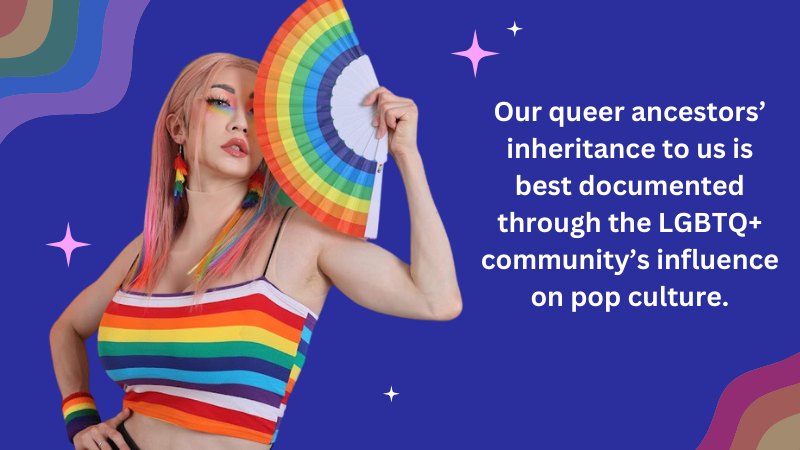
I will dare say that the existence of more genders other than the binary of male and female already exists.
Although this is true, we don’t have the history to back it up, as these cases were suppressed and shunned in old societies.
It would take tremendous efforts over the decades for the LGBTQ+ community to put a foot in the door and demand recognition.
The most unforgettable modern-day movement for the LGBTQ+ community was the Stonewall Uprisings at the beginning of 1969.
A year later, the first Pride march was held in New York City.
Our queer ancestors’ inheritance to us is best documented through the LGBTQ+ community’s influence on pop culture.
Art shared through mass media becomes imprinted in human history and will prove the community’s efforts to the next generations.
The LGBTQ+ Manga Genre
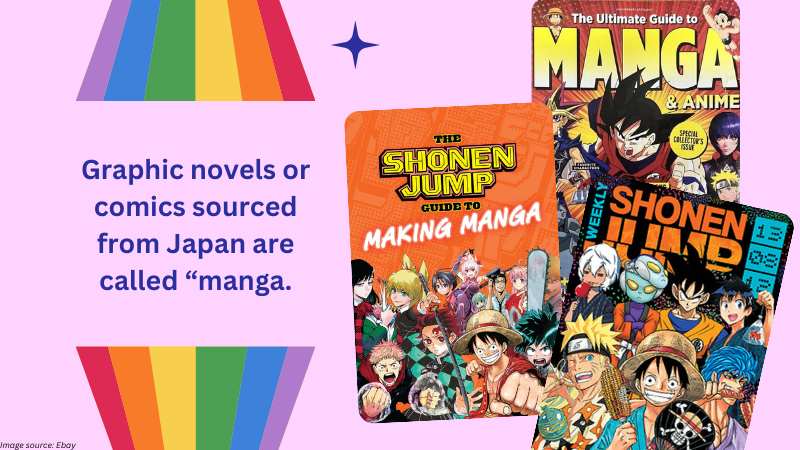
Graphic novels or comics sourced from Japan are called “manga.” It’s an effective way to reach a broader audience for its affordability and diversity.
In recent years, we have seen a boost in the popularity of the LGBTQ+ manga genre.
This may be because of the more welcoming modern society that encourages artists to put forth their new queer plots.
This progress is very crucial as it increases our visibility and offers character presentation.
Additionally, LGBTQ+ manga tends to frame real-life experiences many in the community can relate to.
This fosters understanding and empathy within those who experience the same, and even with those who do not identify as a part of the LGBTQ+ circle.
Before You Start Reading…
There are no requirements before you can choose and start reading a manga.
However, there are instances where the reader may feel overwhelmed by the plot or scenes for various readers.
Subgenre tags
Mangas, no matter who they are created for, always come with additional tags.
In the LGBTQ+ genre, usual tags include Slice of Life, Romance, Action, and others.
These tags help readers sift through the specific works they want to read.
It makes reading more convenient, and you know what to expect within the storyline.
Take advantage of the subgenre tags, as there are thousands of mangas available online.
For instance, you may want a gay love story without any explicit content. Then, you can avoid those with tags like Smut or Yaoi.
Trigger Warnings
Trigger warnings are a more serious form of reading tags. If subgenre tags are helpful, trigger warnings are crucial.
These warnings help readers avoid stirring up unwanted memories or negative emotions the manga may accidentally provoke.
This is especially true in the LGBTQ+ manga genre since they often tackle more serious subjects queer readers may find too close to reality.
Trigger warnings may be about:
Scenes to be expected in the manga some readers may be opposed to, such as:
Major character death or MCD
Physical or emotional cheating
The main pair not ending up together
Bad end
Open ending
Dubious consent
Manipulation or gaslighting
Slow burn
Angst
Porn without Plot (PWP)
Mental health issues that may directly or indirectly be related to their LGBTQ+ identity or experience.
Depression
Self-harm
Suicidal ideation
Eating problems like anorexia or bulimia
Dysphoria
Low self-esteem
Anxiety
Warnings can also be about common experiences many in the community have gone through in one way or another.
Drug or alcohol misuse
Suicide
Bullying
Physical or sexual assault
Public embarrassment
Being outed without permission
Being a social outcast
Family and/or friends’ rejection
Phobia relating to sexuality
Other discriminatory actions related to sexuality
More About Tags

Tags are meant to be helpful. However, some readers find them annoying because they can spoil the storyline.
If you choose not to look at the tags, you are free to do so.
Trigger warnings, on the other hand, are obligatory.
If you want to avoid spoilers and not look at the trigger warnings, you can reach out to someone who already read the LGBTQ+
manga and ask if there are any triggering scenes you should be prepared for.
Most manga authors choose to put trigger warnings before the manga chapter starts.
This gives readers the chance to skip over the chapter altogether.
In the subsequent installment, the author can summarize what happened in the previous chapter so the readers
can continue reading the rest of the manga and avoid being triggered.
Ongoing or Completed
This is just a personal pet peeve of mine, but I don’t like reading ongoing mangas.
If I can, I choose a completed series to avoid overthinking and being disappointed if the plotline suddenly goes haywire.
Moreover, I tend to forget what happened in the previous chapters if I stopped reading for a while.
Active ongoing manga series typically have a weekly or monthly release cycle.
If you don’t mind that release schedule, you can delve into newer titles.
But if you’re like me, then I suggest going for series that are already completed or aren’t chaptered (one-shot mangas).
Author and/or Illustrator
The authenticity of a manga’s title heavily relies on its author’s delivery and the illustrator’s commitment.
If you’re looking for nuanced LGBTQ+ mangas, then an author or illustrator identifying as a part of the
LGBTQ+ community is surely a better storyteller of the community’s struggles and successes.
So, if you don’t mind doing a bit more research on who wrote and drew for the LGBTQ+ manga you plan to get,
try to choose those who genuinely participate in the community.
LGBTQ+ Mangas and Readers
Anyone can read any manga they want. This is also true for anyone, not identifying as a lesbian, gay, bi, trans, or queer.
It’s perfectly okay to identify as one of the traditional binary genders and enjoy LGBTQ+ literature.
It’s also not true that when you consume LGBTQ+ media, you suddenly become “not straight.”
To repeat:
It’s NOT wrong to read LGBTQ+ manga. It may be unconventional, but in no way wrong.
Everyone can can read LGBTQ+ mangas.
You do NOT automatically become gay if you read LGBTQ+ manga.
Top 10 LGBTQ+ Manga
Now that you are prepped to Discover and flip through the peaches of the top LGBTQ+ manga for 2024, here are my recommendations:
Sasaki and Miyano
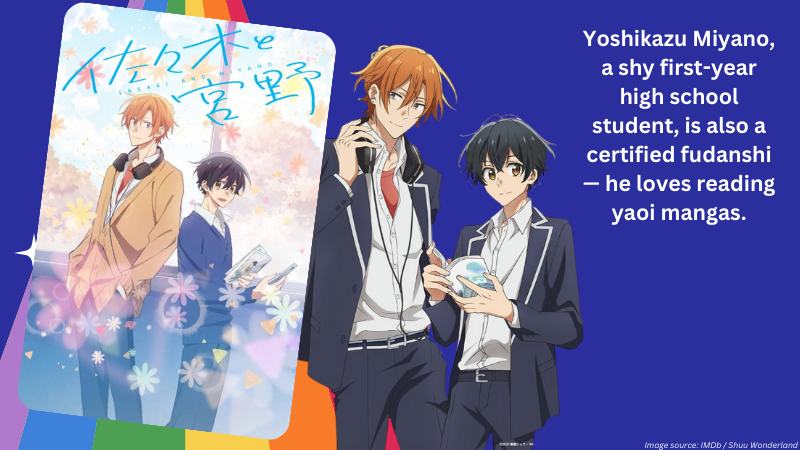
Other Name/s: Sasaki to Miyano
Author/Illustrator: Shō Harusono
Reading tags: Boys’ Love (BL), Romance, School life, Implied Yaoi/Smut (later chapters)
Status: Ongoing
Format/s:
Sasaki and Miyano Animated Series
The plot:
Yoshikazu Miyano, a shy first-year high school student, is also a certified fudanshi — he loves reading yaoi mangas.
(Female yaoi manga readers call themselves fujoshi). It’s just a hobby — he simply enjoys reading this genre and is
aware of the yaoi tropes that happen in his life. Still, it’s not like he can just be so open about it. So he hides this little hobby of his.
He meets Shumei Sasaki at the start of school after Sasaki dispelled a fight. Sasaki’s a second-year student, his senpai.
He had this delinquent look and demeanor, but he’s actually a really nice guy. Miyano even feels comfortable sharing his yaoi recommendations with him.
Over the course of the series, Sasaki realizes he’s falling for Miyano, and he starts to court him.
They eventually end up together.
Why you should read it:
Sasaki and Miyano is the epitome of gay teenage romance.
It depicts the gradual discovery and exploration of the characters’ identities, all within a safe space and healthy pace.
This is something I don’t see often in LGBTQ+ mangas, as most tend to focus on the challenging parts and misunderstandings of being a queer youth.
It’s fluffy, cute, and refreshing. It’s a breath of fresh air that’ll make you feel like you’re rediscovering youthful love by just reading the manga.
The anime also kept true to the manga, though there were skipped scenes to compress the animation.
I Think Our Son Is Gay
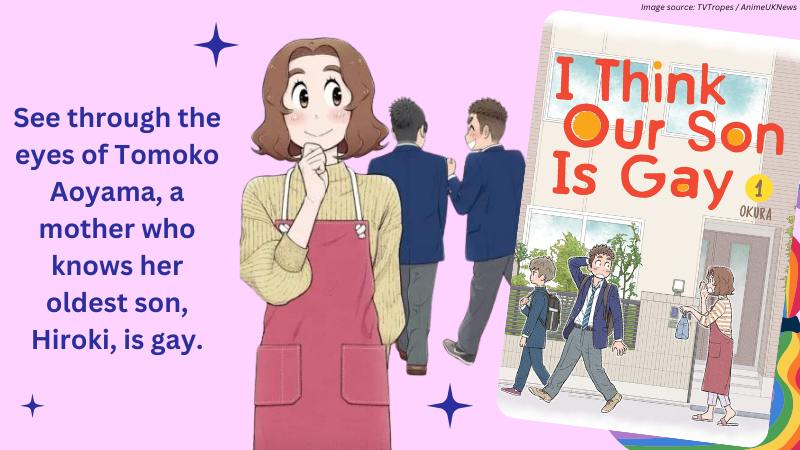
Other Name/s: Uchi no Musuko wa Tabun Gei
Author/Illustrator: Okura
Reading Tag/s: Seinen (for young adult men), Josei (for adult women), Slice of life, Comedy
Status: Completed
Format/s: Manga strips
The plot:
See through the eyes of Tomoko Aoyama, a mother who knows her oldest son, Hiroki, is gay.
But Hiroki’s not ready to tell her that yet. So she supports and accepts him on her own, waiting for Hiroki to reveal his secret whenever he’s ready.
The mother in this series observes her son’s relationships with those around him.
To his younger brother, who knows he’s gay but doesn’t tell him. His father, who sometimes unintentionally hurt his feelings.
To Daigo, his secret crush and classmate. And to his childhood friend, who doesn’t know he’s gay but has feelings for him.
Why you should read it
This is another wholesome manga that shines a bright light on the positive effects of having a great support system.
It shows just how important it is to have someone who supports you, even if you don’t know they do.
The overall web presented in this manga series is all-encompassing.
It shows that a queer individual is not just dealing with their personal life — many other relationships will be affected.
This is why not everyone can just come out of the closet.
Although the manga is a realistic reflection of a queers regular life, it is shown through the eyes of a mother who loves her son.
This way, the readers can sympathize and learn how to let their loved ones have room to be themselves and be good allies to the LGBTQ+ community.
Okura, the creator of the series, was a closeted gay when he started publishing the manga.
With his fans’ support, he came out to his mother. Unfortunately, his mother is the opposite of Tomoko Aoyama.
Now, he writes the series to embody the mother he wishes he had.
Our Dreams at Dusk
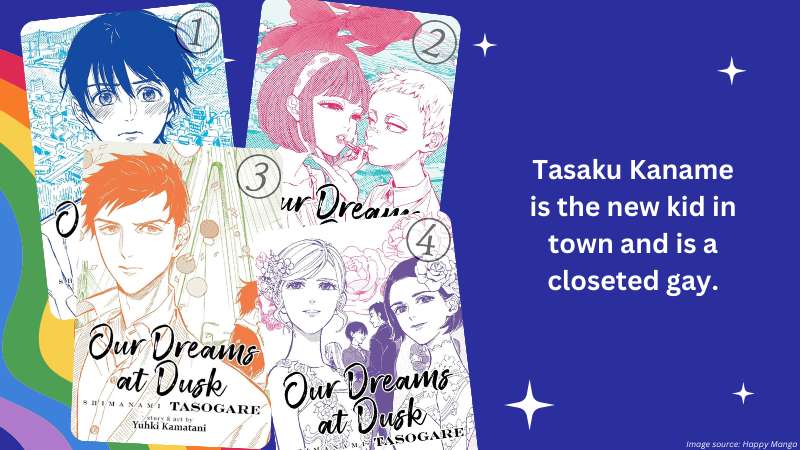
Other Name/s: Shimanami Tasogare
Author/Illustrator: Yuhki Kamatani
Reading Tag/s: Crossdressing, Seinen, Drama, BL, Girls’ Love (GL), Psychological, Romance, Slice of Life
Status: Complete
Format/s: Manga series
The plot
Tasaku Kaname is the new kid in town and is a closeted gay.
After his classmates discovered a gay pornography video on his phone, they bullied him, leading him to think of taking his life.
Then, he sees a woman who jumps from a window and checks if she’s okay.
This encounter leads him to a “drop-in center” where he meets people dealing with similar problems. This center became his haven.
Why you should read it
Our Dreams at Dusk is a very realistic portrayal of what it means to be a queer youth in Japan.
Many experts share that it’s a crucial coming-out narrative for Japanese youth with a lasting impact.
But don’t just listen to the experts. Listen to actual queer people who share their appreciation for the manga.
In a Reddit post, for instance, user LividNetwork shares how the manga helped them be introspective and come out.
A specific scene that I loved in this LGBTQ+ manga series is when the main character meets a proud and out lesbian character who lives with her partner.
It highlighted the difference between Tasaku’s internal turmoil and confusion about his sexuality versus the lesbian woman’s happiness and stability.
Aside from the manga series’ open discussions about queer topics, what’s more memorable to me is Kamatani’s art.
The non-binary’s talent in creating manga panels to showcase the characters’ feelings without needing excessive words or explanations is striking.
Until I Meet My Husband
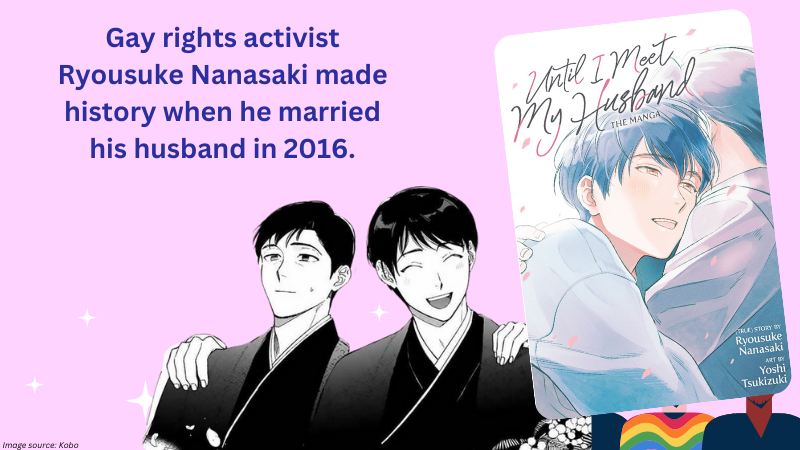
Other Name/s: None
Author/Illustrator: Ryousuke Nanasaki, illustrated by Yoshi Tsukizuki
Reading Tag/s: Real life, Memoir, BL, Mature, Romance
Status: Complete
Format/s:
Manga Series
The plot
Gay rights activist Ryousuke Nanasaki made history when he married his husband in 2016.
Their union was the first religiously recognized same-sex wedding in Japan.
This manga series under the same name illustrates the essay novel he previously released,
where he shares his experiences before meeting his soulmate, starting from when he was in elementary.
Why you should read it
Nanasaki’s essay novel is a raw and honest portrayal of a queer individual. He asked questions, explored, and made mistakes.
Throughout the novel, he shares everything about his journey. He was unafraid to acknowledge when he was in the wrong.
Most writers who do their memoirs tend to censor themselves when discussing the explicit and not-so-good parts of exploring one’s sexuality.
But Nanasaki did not do that. He even asks the readers to detest him when he deserves it.
His memoir ultimately paints him not as a gay man but as a human.
His biography is a treasure trove of knowledge for everyone.
Even if you are not a queer individual, you can relate to Nanasaki‘s desire to outgrow his uncertainties,
his desperation to find love, and the need to celebrate it without measure.
My Lesbian Experience With Loneliness
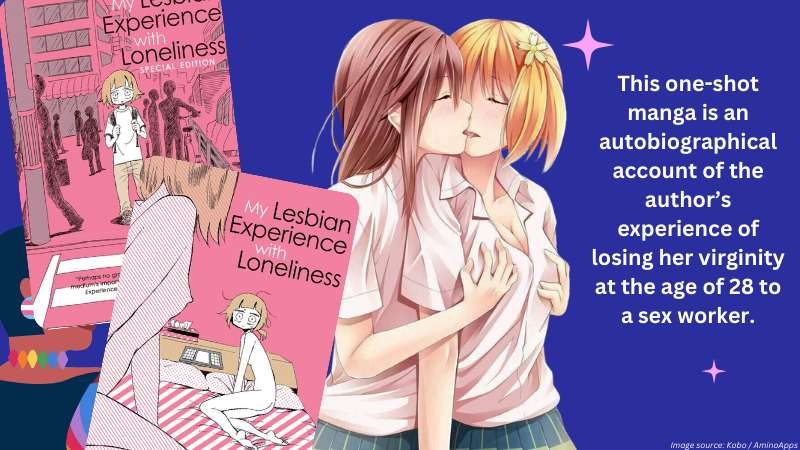
Other Name/s: A Report on Being So Lonely That I Went to a Lesbian Brothel; Sabishisugite Rezu Fūzoku ni Ikimashita Repo
Author/Illustrator: Kabi Nagata
Reading Tag/s: Josei, Mental health issues, Comedy, Slice of life
Status: Complete
Format/s: Comics/One-shot Manga
The plot
This one-shot manga is an autobiographical account of the author’s experience of losing her virginity at the age of 28 to a sex worker.
Above its seemingly shocking plot is the courage to explore sexuality and connect it to one’s mental health.
Why you should read it
Despite its title, this manga is actually more about the author’s relationship with her family and society in general.
It took the internet by storm as many related to her insights about femininity and individuality.
Many reviews say that the author shares the same struggles most autistic people go through.
Bloom Into You
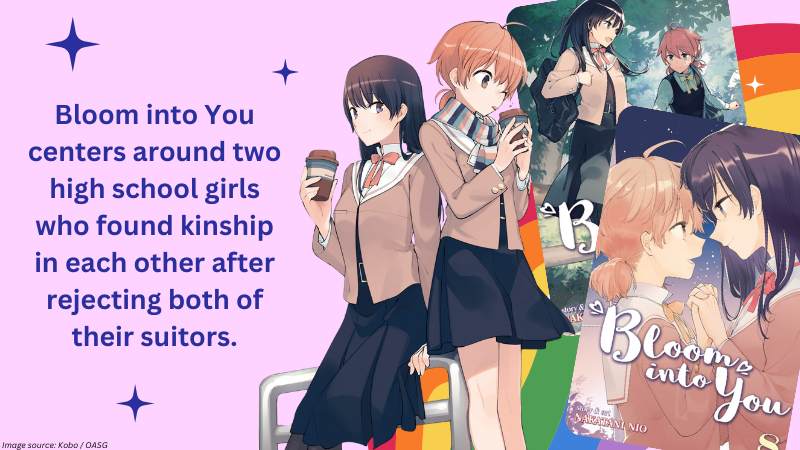
Other Name/s: Dengeki Daioh
Author/Illustrator: Nio Nakatani
Reading Tag/s: GL, Shoujo, School life, Open ending
Status: Complete
Format/s:
Manga series
The plot
Bloom into You centers around two high school girls who found kinship in each other after rejecting both of their suitors.
Why you should read it
Girls’ Love or Yuri is already a popular subset in the LGBTQ+ manga genre.
But not many serializations can hold a candle to Bloom Into You.
It skillfully handled mature themes of girl-to-girl relationships, shedding any problematic elements that can easily arise.
It also did not drag the plot or make it unnecessarily longer.
Bloom Into You is a refreshing read that highlights other aspects of queer relationships that are not usually taken into account in most LGBTQ+ manga.
Just think of courtship, platonic intimacy, and the realistic possibility of never knowing what’s going to happen next.
What Did You Eat Yesterday?
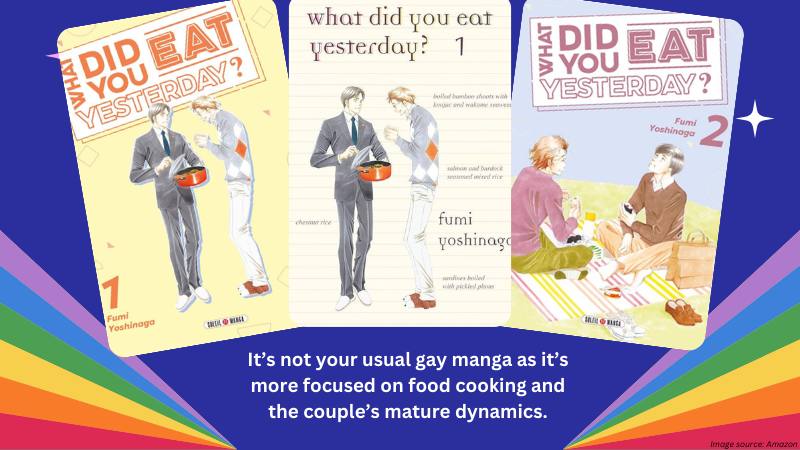
Other Name/s: Kinō Nani Tabeta?
Author/Illustrator: Fumi Yoshinaga
Reading Tag/s: Seinen, Slice of life, Domesticity, Worklife
Status:
Format/s:
Manga series
The plot
Middle-aged gay couple Shiro Kakei and Kenji Yabuki are total opposites.
While Shiro is reserved and uneasy about being gay, Kenji is outgoing and proud of his identity.
Though this is the case, Kenji never disrespects Shiro’s boundaries.
It’s not your usual gay manga as it’s more focused on food cooking and the couple’s mature dynamics.
By the end of the series, Shiro is 52 and Kenji is 50. It also dives into Shiro and Kenji’s domestic life, their workplace, and some LGBTQ+ rights issues in Japan.
Why you should read it
Many complain about the lack of overt intimacy and chemistry between Shiro and Kenji. Somehow, I agree with them.
But I think it’s the whole goal of the manga: To show that gay relationships are not all about physical intimacy or sex.
It’s a realistic portrayal of what two queer people can look forward to when they decide to grow older.
Plus, the original audience was seinen (young adult men) as the manga series ran on a seinen magazine.
But just think of the old couples you know in real life, whether they are gay or not.
They don’t parade their feelings for each other nor display their intimacy out in the open.
That’s because they are already secure and stable in their relationship.
In this work, Shiro and Kenji have already fallen into a routine that works for them.
The fact that they decided to stay together for decades, without needing any laws to bind them,
is already a testament to how strong they feel for each other.
If you’re really looking for that intimacy between Shiro and Kenji, there is a yaoi doujinshi spinoff (Kenji and Shiro-san) you can read after.
After all, Yoshinaga is a well-known BL author. These scenes fit the “in-between” of the original series.
Love Me for Who I Am
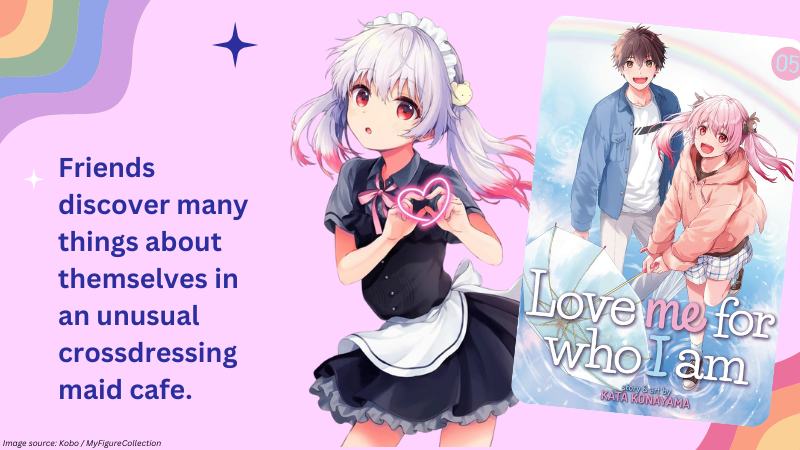
Other Name/s: Fukakai na Boku no Subete o
Author/Illustrator: Kata Konoyama
Reading Tag/s: Seinen, Crossdressing Slice of life, Drama, Romance
Status: Complete
Format/s: Manga series
The plot
Friends discover many things about themselves in an unusual crossdressing maid cafe.
In this cafe, everyone is in various LGBTQ+ stripes, with their own reasons and encounters.
Why you should read it
It’s a manga series that directly urges readers to probe gender identity, gender expression, and sexuality from different perspectives.
If you’re keen on understanding all the nuances of gender and sexuality, this manga should definitely be on your to-be-read list.
Even if you’re not part of the LGBTQ+ community, anyone who wants to be an ally should read this manga for its realistic
setting and depiction of how language should be handled when it comes to sexual identities especially those of trans.
A prequel, Kimi Dake no Ponytail, centers around a boy who likes to crossdress, a classmate who discovers his preference, and their relationship (it’s explicit).
Doughnuts Under a Crescent Moon

Other Name/s: Kaketa Tsuki to Dōnattsu
Author/Illustrator: Shio Usul
Reading Tag/s: GL, Yuri/Smut, Office romance, Fluff, Slow burn
Status: Complete
Format/s: Manga series
The plot
Uno Hinako just wants to be “normal.” So, pushed by her friends and family, she desperately tried to look and act like the “ideal young woman.”
She’s into fashion and makeup, and is desperate to fall in love. Still, none of her “normal” romance exploits pan out.
That’s until she meets her co-worker Asahi Sato.
Why you should read it
This manga deals with many subjects connected to attraction and attachment.
It also explores the meaningful forms of affection and is big on emotional intelligence with dynamic characters.
Though tagged as a yuri series, it’s also a great read for those who identify as ace, aroace, and demisexuals.
She Loves to Cook, and She Loves to Eat
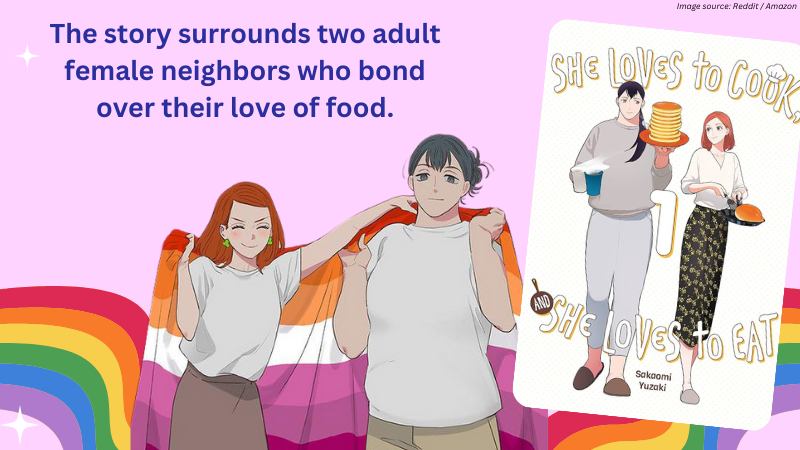
Other Name/s: Tsukuritai Onna to Tabetai Onna
Author/Illustrator: Sakaomi Yuzaki
Reading Tag/s: GL, Yuri/Smut, Slice of Life
Status: Complete
Format/s:
Manga series
The plot
The story surrounds two adult female neighbors who bond over their love of food.
After an impromptu dinner invitation, they became friends and slowly transitioned into something more.
Why you should read it
Maturity is the theme of this manga. Beyond the sexual and physical connection of the characters is the development of their romantic and emotional connection.
Unlike most manga series that tackle queer curiosity and exploration, this work focuses on how to build mature relationships through shared interest and friendship first.
Mangas like this are important to showcase what a healthy, romantic relationship between queer individuals looks like.
Conclusion
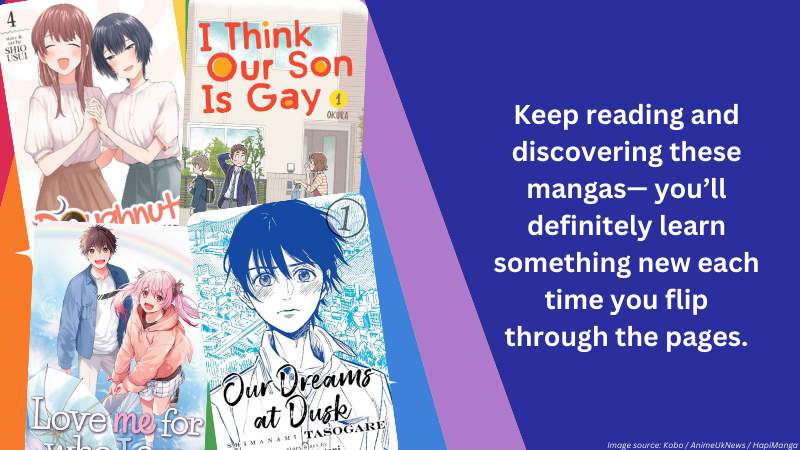
Those in the LGBTQ+ community today are lucky to have an array of LGBTQ+ literature to learn and explore sexuality through others’ experiences and narratives.
The LGBTQ+ manga genre is an effective channel to start conversations about important issues in the LGBTQ+ community.
Keep reading and discovering these mangas— you’ll definitely learn something new each time you flip through the pages.
Whenever you consume this type of media, you also support LGBTQ+ creators and allies and maintain the community’s visibility.
FAQs
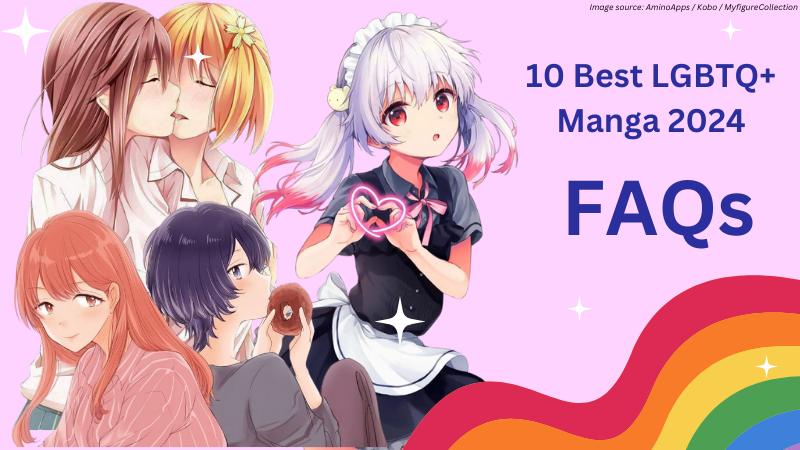
How can I access LGBTQ+ manga if I live in a region where it’s not readily available?
If you want to have a physical copy of the manga, you can reach out to a friend who lives in Japan and have
them ship the manga to you or order from major outlets like Kinokuniya, Amazon.co.jp, or CDJapan.
Alternatively, you can access the manga on online platforms if they are available in digital versions.
If you can, only use platforms that directly work with the creator.
Are there specific genres or subgenres within LGBTQ+ manga that cater to different preferences?
Yes— whatever your preference is there is a genre or subgenre that can satiate your hunger in manga.
For instance, it’s not unusual for LGBT+ mangas to cater to specific kinks and fetishes, like crossdressing,
muscle (bara), femboys, or BDSM like master-slave and bondage.
How can I support LGBTQ+ manga creators and ensure diverse representation in the industry?
There are many ways to do this. Personally, I follow my favorite manga creators on their social media accounts.
Mostly, it’s through Twitter (X), and wait for any news they share.
- Crossdresser: Exploring the Behavior, Origins, and Social Context
- Crossdresser vs. Transgender: What’s the Difference and Why Does It Matter?
- Why Do Some Straight Men Enjoy Crossdressing?
- 7 Best Mtf Trans and Crossdresser Podcasts in 2024
- Journey With Roanyer : Your Beginner Crossdressing Store
- The Intersection of Cosplaying and Crossdressing
- What Are Some Beginner Crossdresser Essentials?
- Caught Crossdressing: How to Handle the Shock and Move On
- What Challenges Do Crossdresses Face? Essential Tips for Beginners
- Microdosing Femininity: Simple Ways to Embrace Your Feminine Energy
- Crossdresser’s Guide: How to Stuff Your Bra and Make It Look Real
- How to Take Sexy Pictures: Tips and Tricks for Crossdressers
Established in 2009, We are a recognized manufacturer and seller of professional crossdressing products.
It is our aim to become not just the most creative manufacturer but also a very considerate seller, as we provide the best quality products for crossdressers all around the world.












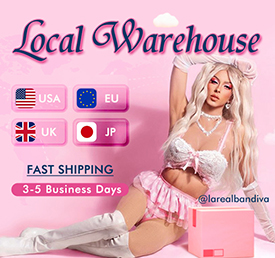

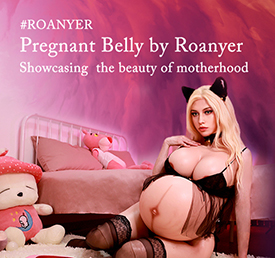





 Breast Forms
Breast Forms  Body Suit
Body Suit  Realistic Mask
Realistic Mask  Femini Girdle
Femini Girdle Hip & Butt Enhancement (8)
Hip & Butt Enhancement (8) Penis Prosthesis
Penis Prosthesis Fake Muscle
Fake Muscle Bikini
Bikini  Wig
Wig  Corsets
Corsets Course
Course service@roanyer.com
service@roanyer.com +8618652200711
+8618652200711 Facebook
Facebook YouTube
YouTube Twitter
Twitter Instagram
Instagram




